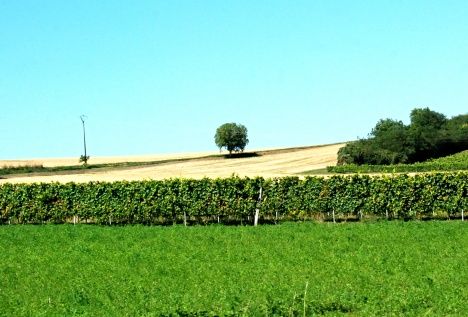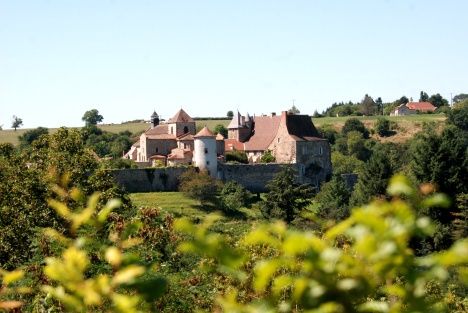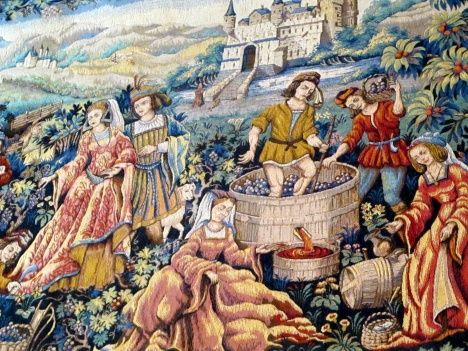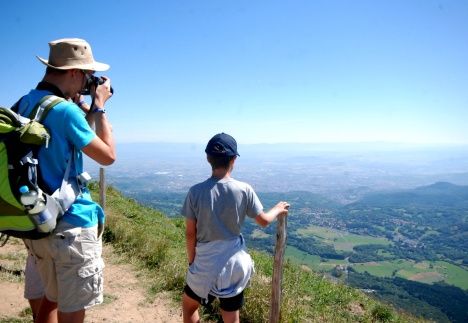 |
| You almost have to look for them% the vineyards in the Auvergne (Photo: P. Züllig) |
But there are two wine regions in the Auvergne that together cover hardly more than 1,500 hectares: the Côtes d'Auvergne and the St-Pourçain appellation. St-Pourçain - I was told - is the centre of good wine today. There is even a wine route through the surrounding wine communities, which - according to the travel pocketbook - "combines art-historical destinations with visits to wineries". Anyone familiar with wine routes on the Loire, in the Bordelais, in the Languedoc or on the Rhône will be surprised. I can't see any signs or vines for long stretches. But I end up in Chareil-Cintrat, at a 16th-century chateau that stands in the middle of harvested cornfields. In Deneuille - or was it Fleuriel? - I discover a former monastery and gain new hope. Where monks lived, there must also be wine. Lots of greenery there, too, but no vines far and wide; even the wineries promised in the guidebook I can't find - despite the narrowness of the villages. Only after a long drive on narrow roads - in Montord and especially in Saulcet - do I come across larger vineyards, not just a few small vineyards. One consolation: the hills, one after the other, the alternation of brown fields, where only recently there was grain, and the lush green meadows are beautiful to look at - well worth a wine road trip.
 |
| A former monastery% monumental building in the middle of a lonely area% dominated by agriculture (Photo: P. Züllig) |
Perhaps I didn't spend enough time encountering the wine of the Auvergne after all. In Saint-Pourçain-sur-Sioule - a small town - I find clear traces of wine: in the municipal coat of arms the royal lily enthroned above a wine barrel, an exemplary wine museum in a historic tower, a cooperative winery, posters and banners referring to a "Festival viticole et gourmand", and - next to the mairie - a restaurant with a sign "Cave à vin... mais pas que" (Wine cellar, but not only). In fact, wines from the area are also served here. So for the very first time I have a wine from Auvergne in my glass. My first association: Dôle. Dôle is the most popular Swiss red wine, a cuvée of Pinot Noir and Gamay that is only produced in Valais. There is no grape variety called "Dôle". The wine is fruity and powerful with aromas of wild berries, liquorice, cassis and a slightly peppery finish.
 |
| Finally found: a larger vineyard% almost one hectare in size (Photo: P. Züllig) |
Indeed, in Auvergne, Pinot Noir and Gamay also dominate the red grape varieties, from which an assemblage is made, but it is much lighter, much more cheerful, even more elegant than the Dôle. Astonishingly mineral on the nose, rather fruity on the palate, red currants, no forest floor heaviness, rather light undergrowth. Obviously, there is more Gamay in the cuvée than in the Dôle. The wine doesn't thrill me, but I like it. It nestles perfectly with the cheese-ham-sausage platter that is served here. If I were to drink the wine anywhere - not in Auvergne - it would be a pleasant, light, buoyant little wine, by no means a dominant, down-to-earth Dôle.
But the wine regions in Auvergne are best known for their white wines. The Sacy (Tressalier) grape variety produces a light, drinkable, rather low-acid wine. I would have liked to drink it here - where it is actually at home - perhaps as an alternative to rosé. But it was not to be found in the few gourmet shops I visited. It seems that in the meantime, the far better known Chardonnay has also found its way here. For me, this is a sign that the trend towards the mainstream - especially in the wake of the tourists - is continuing here. A Chardonnay, as it is increasingly planted and vinified worldwide. In terms of quality, it is certainly to be rated higher than the rather well-behaved Sacy, but lower in comparison with the best Chardonnays produced all over the world. It is actually a pity that in a wine region with a "lost name" one does not build more on independence and specialness and rebuild what has grown over centuries.
 |
| Medieval representation of winemaking in Auvergne (Photo: P. Züllig) |
The soil, the climate and the rivers Allier, Sioule and Bouble (on which the wine regions lie) would be ideal conditions for independent Auvergne wines, perhaps even autochthonous grape varieties, which certainly once existed here. But I, at least, have discovered nothing of that. The cheeses - five AOC cheeses: Saint-Nectaire, Cantal, Bleu d'Auvergne, Fourme d'Ambert and Salers - (rightly) dominate the gourmand scene. The fresh tomme from Cantal (this is a region of Auvergne) makes the truffade - popular potato dish with cheese, smoked bacon, crème fraîche and black pepper - so unique, so typically "auvergnat", actually peasant and yet also a culinary experience in any fine cuisine. The right wine to go with it, not a Chardonnay, but rather a fresh, fruity Tressalier (the more Tressalier in it, the better) or a Gamay-accented red wine that - unlike the Dôle - combines its aromas with the usually hearty dish and complements it with its freshness and volcanic minerality.
 |
| The Auvergne% as Blaise Pascal must have experienced it (Photo: P. Züllig) |
The Auvergne is not a wine region (any more). It is also not a usual tourist area, where people from all over the world (mostly from air-conditioned buses) stream out for a few hours to admire the beauties, the other, the landscape, the historical monuments, and then move away again to the next sight. The hiker, the sportsman, the loner, the nature lover (still) dominates here. You can't travel fast in the Auvergne. You have to stop, look and become still. The volcanoes that shaped the region millions of years ago stand there as sometimes bizarre, sometimes inviting hills and mountains where man can feel at home or, as Blaise Pascal described it: "... the more you approach, there are houses, trees, bricks, leaves, grasses, ants, ant legs to infinity. All this is hidden in the name landscape." Perhaps - if you get close enough - it also hides (again) a wine in its own right that fits entirely into this landscape.